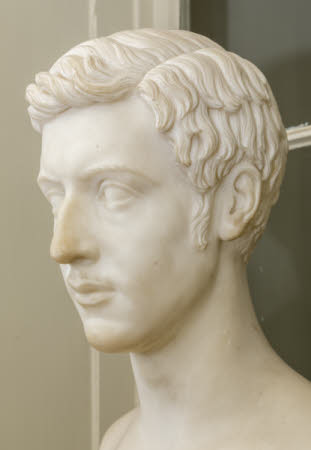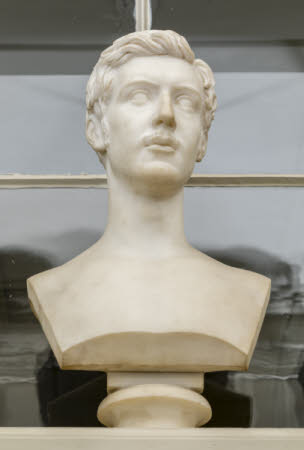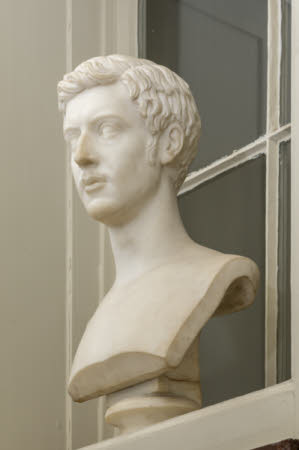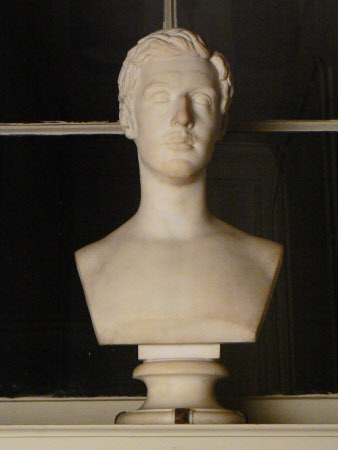William Tollemache, 9th Earl of Dysart (1859-1935)
Alexander Macdonald (b.1847)
Category
Art / Sculpture
Date
1879
Materials
Marble
Measurements
570 mm (H); 330 mm (W); 230 mm (D)
Place of origin
Rome
Order this imageCollection
Ham House, Surrey
NT 1139716
Summary
Marble; bust of William Tollemache, 9th Earl of Dysart (1859-1935); Alexander Macdonald (born 1847); 1879. White marble bust mounted on a circular marble pedestal
Full description
William Tollemache, 9th Earl of Dysart (1859-1935) was the last Earl of Dysart to live at Ham House, and was responsible for the saving of the house, which he inherited at the age of nineteen in 1878, by overseeing its sensitive restoration (for the restoration of Ham House, see Michael Hall, ‘Bodley and Garner and Watts & Co: Repairs and Renovation at Ham House for William Tollemache, 9th Earl of Dysart’ in Rowell, Ham House, pp. 374-82.). William Tollemache was born partially blind, and suffered increasingly from deafness in the course of his lifetime, which must have been especially distressing for this ardent music lover. His nervous disposition is well caught in Alexander Macdonald’s sensitive portrayal. Alexander Macdonald was the son of the Scottish neo-classical sculptor Laurence Macdonald (1799-1878), sometimes known as the ‘Scottish Canova’. In 1832 Laurence Macdonald left Scotland for Rome, where he lived for the rest of his life, developing a highly successful career as a portrait sculptor catering to the many cultivated and fashionable British visitors to the city. Eventually taking over Bertel Thorvaldsen’s former studio in the Piazza Barberini, Laurence Macdonald was assisted by his older brother John and, in later years, his son Alexander, born in Rome in 1847, whose bust of the 9th Earl of Dysart by Alexander Macdonald follows in the tradition of his father’s portrait sculptures. Very little is known about Alexander Macdonald, who exhibited works at the Royal Academy in London in 1868 and 1878, but who continued to live and work in Rome. A bust by Macdonald depicting James Thomas Brudenell, 7th Earl of Cardigan (commanding officer of the Charge of the Light Brigade) and dated 1869 was offered at auction in 2021 (Sotheby’s London, 15 December 2021, lot 19). The bust of the 9th Earl of Dysart is, along with a Venus and Cupid group also dated 1879 (Christie’s London, 19 March 2009, lot 168; Sotheby’s London, 23 November 2010, lot 11), the latest known work by Alexander Macdonald, the remainder of whose life is currently shrouded in mystery. It is perhaps significant that both works are dated the year after the death of Laurence Macdonald, and perhaps they represent an attempt by the son to continue the father’s business. The donor of the bust, the Hon. Mrs Veronica Innes (1917-2018), was the great grand-daughter of the 8th Earl of Dysart. Jeremy Warren December 2021
Provenance
Given by the Hon Mrs Veronica Innes in 2002.
Marks and inscriptions
At back : ALEXR. MACDONALD FECIT ROMAE 1879
Makers and roles
Alexander Macdonald (b.1847), sculptor
References
Rowell 2013: Christopher Rowell (ed.), Ham House, 400 Years of Collecting and Patronage, Yale University Press, New Haven & London 2013, p. 374, fig. 385.



